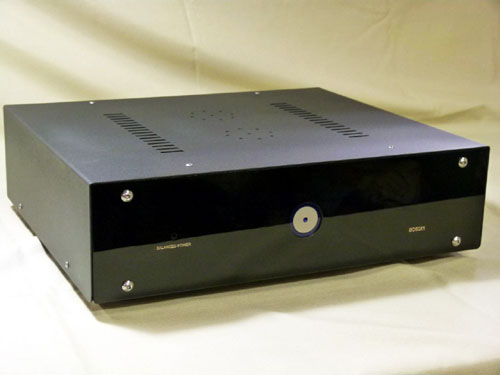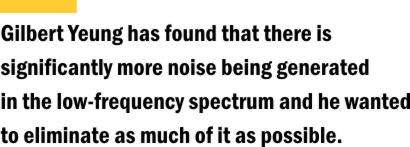Blue
Circle Audio • BC60X1 Power Conditioner
". . . aiding your system to reach its fullest potential."
udiophiles will spend a great many hours researching, examining and listening to each piece of equipment in their systems, whether it be a source, a preamp or power amp, speakers, even cabling. But one area that many audiophiles don’t pay quite as much attention to is their power; more to the point, they don't expend the same effort finding a product to manage and improve the quality of their power, which influences every part of their systems' performance. And that’s too bad, because if your power isn’t as clean as possible, it can have disastrous effect on the sound of the gear you've spent so much time agonizing over.
The BC60X1 is Blue Circle's third-generation power-line conditioner. Weighing in at a robust 42 pounds and standing 17" wide, 14 1/2" deep and 4 1/2" high, it's more like a power amp in stature than a power product and something whose final resting place you'll want to identify right off, so you don't have to move it. But with that weight come vast improvements over earlier efforts. Around back is where all the action is. You see twelve outlets, six filtered and six filtered and balanced. The six filtered outlets don't limit current, so they're ready for any (and I mean any) power amp, integrated amp, or subwoofer you want to plug in. So far Gilbert hasn’t found anything that will cause the BC60X1 to even break a sweat before the breaker in your box trips -- that’s how robust the BC60X1 is. The other six outlets are both balanced and filtered, so they provide a constant 120V -- perfect for any source component you want to use. All outlets come with two and a half times the filtering of Blue Circle's BC6020 Studio Reference power conditioner.
Finally, you will see a switch in the middle between each set of outlets marked Quiet and Bypass. This switch toggles between normal operation and the addition of a DC-offset blocking circuit. DC on the power line can cause transformers to hum or buzz, so if you hear any mechanical noise coming from the transformers of your electronics, just give the switch a flick and see if the noise goes away. I had no issues, so I can’t comment on the circuit's effectiveness, although if Gilbert thinks it's worthwhile, who am I to argue? There is also a reset button on the bottom of the unit, but you’d have to suffer some real AC problems to have to use it. own a previous-generation Blue Circle power conditioner, the BC6000 ($1795), which I reviewed a number of years ago -- in December of 2007, to be exact. I was so taken with it that I added it permanently to my system. I have enjoyed the way it opened up my system's sound and really let it sing. But when I replaced it with the BC60X1 and played the first disc, Tiny Island [Opus 3 SACD CD 19824], I heard significant differences, all to the betterment of the music. Tiny Island is chock-full of acoustic instruments recorded in real space. The BC60X1 presented a darker -- as in quieter -- and cleaner background for the music than I had previously heard. There really was detail present that I’d never noticed before, such as the way fingers slide over guitar strings or the seeds within the maracas sounding almost individual. Notes trailed off into space, rendered more clearly than I was used to with the BC6000. When I moved on to another well-recorded and -mastered SACD, Closer to the Music Vol.3 [Stockfisch Records SFR 357.4009.2], I cued up the track by The Paperboys, "Waiting." This track was recorded live in the Stockfisch studios, and I could always hear that "liveness" with the BC6000 in my system. But with the BC60X1, the sense of the musicians being in the same room playing and interacting was presented more clearly. The sense of studio space was more real now. And vocal harmony, a big part of the performance, was made more clear. I could now better hear the individual singers’ voices and how they intertwined with each other. I could also place singers and instruments within the soundstage with greater accuracy. As I listened to the many and varied vocal presentations on the Closer to the Music Vol.1 SACD [Stockfisch Records SFR 357.4003.2], I could more clearly hear the changes in the manner Allan Taylor uses in his sing/speak of his song "The Beat Hotel," or the gruff, world-weary, whisky-soaked vocals of Davis Munyon on his song "Words of Love," to the deep yet harder-edged voice of Paul Stephenson on his song "Captain of the Loving Kind." Each was presented as a real, honest singer standing in front of me. Classical music is a stiff test of how well a power conditioner is doing its job, due to the variety of tonal voices that make up a symphony orchestra, as well as the complex dynamic shading of many of the compositions, especially in good recordings, so many of which also present a real sense of acoustic space. On the CD of Aaron Copeland’s "Fanfare for the Common Man" [Reference Recordings RR-93CD], the tympani seems to start from a deeper place as it rumbles to life with the BC60X1. The way it builds in intensity is more true to life, ensuring that the power to my system is as clean and plentiful as possible. When the brass makes its entrance, it has a startling immediacy, full of brassy power. All of this comes from a background that is devoid of any noticeable noise. Finally, I grabbed one of my Dead Can Dance SACDs, Spleen and Ideal, [Mobile Fidelity/4AD WPCB-10072/SAD 2707], and heard how the clarity the BC60X1 brought to my system made the dense mix more accessible. I was suddenly more immersed in the music created by Brendan Perry and Lisa Gerrard of Dead Can Dance. I could hear more of the way they wove different musical influences together to make their music a complete, final entity. In comparing my BC6000 to the much newer BC60X1, the first thing that jumped out at me was a slight but noticeable lessening of acoustic space; the noise floor increased enough with the BC6000 back in the system to be noticeable in direct comparison. On Andy McCloud’s CD Blues For Big Head [Mapleshade 07832], a live-in-studio all-analog recording, the BC60X1 presented space aplenty. With the BC6000, as good as it is, the air around the musicians began closing in on them. It took away a sense of believability from the recording. Had I not heard this with my own ears and my own system, I wouldn’t have believed it. There was also a slight loss of texture and detail with the BC60X1 out of the system. As I played the SACD of Steve Davis’s Sound of Silence [DMP SACD-04], an absolutely stunning recording, I no longer heard the sound of Davis’s wood sticks striking brass cymbal as cleanly and clearly when the BC60X1 was removed, and I could also no longer get a sense of where on the cymbal those strikes occurred. Again, I found this lessened the illusion of hearing real musicians playing in my listening room. fter spending time with the Blue Circle BC60X1, and obsessing over it as much as I have the other parts of my audio system, I have come to the conclusion that it comes a true step closer to erasing the electronic haze that comes between listener and music. With the BC60X1 in my system, it was easier to close my eyes and feel as though I was in the presence of the musicians. It truly does filter and condition the power that comes from the wall and makes it less of an impediment to the music. I can’t think of a better way to take a quality audio system that next step to a straight wire with gain than adding the Blue Circle BC60X1. Gilbert Yeung’s almost obsessive need to tinker and improve on his previous designs has paid big dividends. Not only does the BC60X1 offer both conditioning and filtering in a manner that doesn’t impede the music coming out of the speakers, but it also offers more than enough outlets to handle even the largest systems. While the BC60X1 is not inexpensive, the order of
magnitude of improvement, especially over no conditioning or filtering at all, makes it a
bargain of sorts for audiophiles looking to take that last step toward a system that
allows listeners to drift away, lost in the music. Once heard, it will be very difficult
not to want what the BC60X1 offers, aiding your system to reach its fullest potential.
|
|||||||||||




 And unlike most power
conditioners on the market, the BC60X1 pays particular attention to the grunge between 5
and 50Hz as well as from 50Hz on up. Gilbert Yeung has found that there is significantly
more noise being generated in the low-frequency spectrum and he wanted to eliminate as
much of it as possible. He developed a proprietary filtering method, dubbed X1e. This is a
filter module that combines multiple circuits and specifically targets noise between 500Hz
and 5kHz. It is in parallel to to the unit's main filter circuit, and the BC60X1 is the
first product to use it. Gilbert also uses a special core material and wire for the
transformer (and no, he's not saying what it is; only that after exhaustive research did
he decide on the material he’s using), in order to offer the speed and transient
performance he demands.
And unlike most power
conditioners on the market, the BC60X1 pays particular attention to the grunge between 5
and 50Hz as well as from 50Hz on up. Gilbert Yeung has found that there is significantly
more noise being generated in the low-frequency spectrum and he wanted to eliminate as
much of it as possible. He developed a proprietary filtering method, dubbed X1e. This is a
filter module that combines multiple circuits and specifically targets noise between 500Hz
and 5kHz. It is in parallel to to the unit's main filter circuit, and the BC60X1 is the
first product to use it. Gilbert also uses a special core material and wire for the
transformer (and no, he's not saying what it is; only that after exhaustive research did
he decide on the material he’s using), in order to offer the speed and transient
performance he demands.